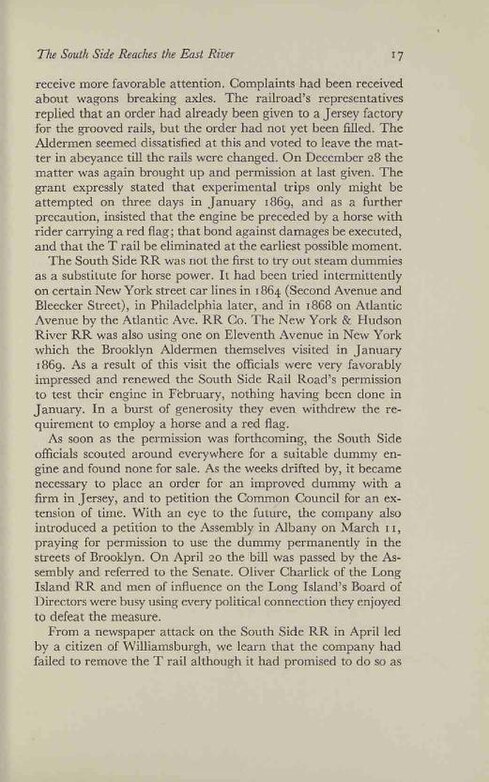receive more favorable attention. Complaints had been received about wagons breaking axles. The railroad's representatives replied that an order had already been given to a Jersey factory for the grooved rails, but the order had not yet been filled. The Aldermen seemed dissatisfied at this and voted to leave the matter in abeyance till the rails were changed. On December 28 the matter was again brought up and permission at last given. The grant expressly stated that experimental trips only might be attempted on three days in January 1869, and as a further precaution, insisted that the engine be preceded by a horse with rider carrying a red flag; that bond against damages be executed, and that the T rail be eliminated at the earliest possible moment.
The South Side RR was not the first to try out steam dummies as a substitute for horse power. It had been tried intermittently on certain New York street car lines in 1864 (Second Avenue and Bleecker Street), in Philadelphia later, and in 1868 on Atlantic Avenue by the Atlantic Aye. RR Co. The New York & Hudson River RR was also using one on Eleventh Avenue in New York which the Brooklyn Aldermen themselves visited in January 1869. As a result of this visit the officials were very favorably impressed and renewed the South Side Rail Road's permission to test their engine in February, nothing having been done in January. In a burst of generosity they even withdrew the requirement to employ a horse and a red flag.
As soon as the permission was forthcoming, the South Side officials scouted around everywhere for a suitable dummy engine and found none for sale. As the weeks drifted by, it became necessary to place an order for an improved dummy with a firm in Jersey, and to petition the Common Council for an extension of time. With an eye to the future, the company also introduced a petition to the Assembly in Albany on March 11, praying for permission to use the dummy permanently in the streets of Brooklyn. On April 20 the bill was passed by the Assembly and referred to the Senate. Oliver Charlick of the Long Island RR and men of influence on the Long Island's Board of Directors were busy using every political connection they enjoyed to defeat the measure.
From a newspaper attack on the South Side RR in April led by a citizen of Williamsburgh, we learn that the company had failed to remove the T rail although it had promised to do so as
